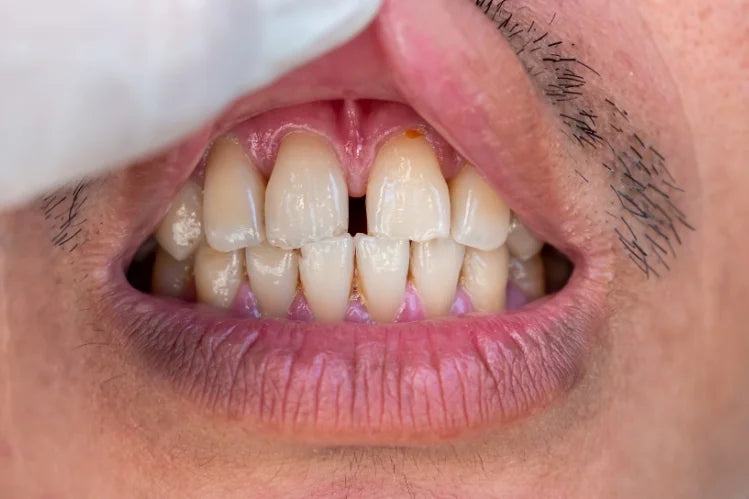
Table of Contents
Have you ever felt uncomfortable while smiling because of the gaps in your teeth? Some people find it a characteristic of their smile, while many others want to remove the gap between their teeth. This gap is known as diastema, which is defined simply as having extra space between two or more teeth. It usually appears between the front teeth but can happen anywhere in the mouth.
While many people only see diastema as a cosmetic issue, gaps in your teeth can contribute a lot to your overall dental health. From genetics to periodontal disease, there are many reasons why this gap can occur. On the flip side, there are also many ways to fix the gap! In this blog, we will go into what causes diastema, what problems diastema can create, and how to treat it. We will also discuss how Smilepath Clear Aligners can treat diastema easily and effectively.
What Causes Teeth Gaps?
Understanding why teeth spacing happens can help you find the right way to fix it. Here are some common reasons:
Family Traits
If your parents or grandparents have a gap in teeth, you might have inherited it. The size and shape of your jaw and teeth play a big role in diastema.
Jaw and Tooth Size Mismatch
If your teeth are too small for your jawbone, they may not fit closely together, creating teeth spacing.
Overgrown Labial Frenum
The labial frenum is a piece of tissue that connects your upper lip to your gums. If it is too big, it can push your front teeth apart, causing a gap in teeth.
Thumb-Sucking and Tongue Pressure
If you sucked your thumb as a child or pushed your tongue against your teeth often, it can create gaps in teeth over time.
Gum Disease
This condition weakens the gums and bones that hold your teeth in place, leading to movement and teeth spacing.
Missing Teeth
Teeth spacing can also occur if you have lost a tooth or two. If you lose a tooth and don’t replace it, nearby teeth can shift, causing gaps.
Can Gaps in Teeth Close on Their Own?

Some gaps in teeth close naturally, but it depends on the cause. If a child has gaps while their adult teeth are growing in, they may disappear as the new teeth come in. For instance, a study noted that midline diastemas occur in approximately 98% of 6-year-olds, 49% of 11-year-olds, and 7% of individuals aged 12 to 18. The natural eruption of lateral incisors and canines typically contributes to the spontaneous closure of these spaces. But in adults, teeth spacing usually stays the same or even gets worse unless treated.
If a habit like thumb-sucking causes a gap in teeth, stopping the habit might help the teeth move back. However, in most cases, professional treatment is needed to fully close the space.
Problems Caused by Teeth Gaps
While some people love their diastema, large gaps in teeth can cause problems, such as:
- Bite Problems: If teeth are too far apart, it can change how your top and bottom teeth fit together, making chewing harder.
- Speech Issues: Teeth spacing can cause lisps or other speech problems.
- Food Getting Stuck: Food can get trapped in gaps in teeth, leading to plaque buildup and cavities.
- Gum Problems: Exposed gums between widely spaced teeth are more at risk of infection.
- Tooth Damage: Uneven pressure on misaligned teeth can make them more likely to crack or break.
- Confidence Issues: Some people feel self-conscious about their gap in teeth and want a more even smile.
How to Fix Teeth Spacing
If you want to fix teeth spacing, here are some popular treatments:
Clear Aligners
Clear Aligners are the real game changers in orthodontics. They are thin clear trays that are customized especially for your teeth. They are nearly invisible and help shift your teeth gradually into place. Brands like Smilpath provide an at-home clear aligner treatment which makes it the most effective and convenient option for fixing the gaps in your teeth.
Braces
One of the most common and effective ways to fix teeth gaps is metal braces. They use wires and brackets to slowly move teeth together. But treatment with metal braces takes anywhere from 12 to 24 months, they are very visible, and metal wires and brackets can irritate. They also require regular dental visits for maintenance and fixing. So, they might be one effective choice but they are not very convenient.
Dental Bonding
Another method can be dental tooth bonding. It is a tooth-colored material used to fill in small gaps in teeth. This is a quick and affordable fix but this does not cater to severe cases and may not last as long as other treatments.
Veneers
Veneers are an aesthetic treatment that does not solve the actual issues caused by teeth spacing. It only helps in hiding the gaps to enhance your aesthetic appearance. These are basically thin shells placed over the front of the teeth to cover teeth spacing. They look natural but require removing some enamel. Although they solve the problem at the front, they damage the enamel of teeth while not addressing the root cause.
Frenectomy
It is a surgical procedure that removes or alters the frenulum. If a large labial frenum is causing the teeth gap, a small surgery like a frenectomy can fix it and then eventually all teeth will grow into their right places.
Why Choose Smilepath Clear Aligners?

Smilepath clear aligners are a great choice if you want to fix teeth spacing without metal braces. Here’s why:
- Almost Invisible: Unlike braces, they are clear and blend in with your teeth.
- Made Just for You: Each aligner is custom-designed to move your teeth gradually.
- Removable: You can take them out to eat, drink, and brush your teeth.
- Works Faster: Smilepath aligners can show results quicker than traditional braces.
- Affordable: Payment plans make them easier on the budget.
- Safe and Effective: Created by orthodontic experts to ensure great results.
Conclusion
Having gaps in teeth isn’t always a bad thing, but in some cases, it can lead to dental issues or affect your confidence. Thankfully, modern treatments make it easier than ever to fix teeth spacing without traditional braces. Smilepath Clear Aligners offer a simple, comfortable, and effective way to close teeth spacing and improve your smile.
If you’re thinking about closing your gap in teeth, now is a great time to explore your options. A confident smile could be just a treatment away!
FAQs
Teeth can space apart due to genetics, gum disease, thumb-sucking, missing teeth, or a mismatch between jaw size and tooth size.
Ideally, teeth should fit closely with minimal space. However, a tiny gap of about 0.5-1 mm is normal and helps maintain gum health.
Tooth spacing, or diastema, refers to gaps between two or more teeth. It can be natural or caused by various dental factors.
A lack of vitamin D and calcium can weaken bones and gums, leading to shifting teeth and gaps over time.
Citations:
Specialistorthodontistadmin. (2020, May 5). Spacing. Specialist Orthodontist. https://specialistorthodontist.com.au/orthodontic-problems/spacing
Department of Health & Human Services. (n.d.-b). Teeth - gapped teeth. Better Health Channel. https://www.betterhealth.vic.gov.au/health/conditionsandtreatments/teeth-gapped-teeth






 Australia
Australia New Zealand
New Zealand Malaysia
Malaysia English
English Portuguese
Portuguese English
English English
English English
English English
English English
English Canada
Canada